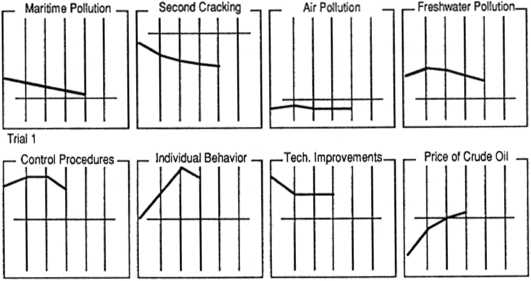36
Joachim Funke

Figure 4. Screen display of ALTθL on the fifth simulated week of a trial (graphical condi-
tion). Upper part: endogenous variables (straight lines: goal values), lower part: exogenous
variables (straight lines: zero intervention). The end points of the exogenous variables can be
dragged in the upper or lower edge of the box in order to indicate the degree of a positive or
negative intervention.
Dependent variables were QSC and QSI. Because for subjects in the
condition with only partial system control a general QSC-score could not be
computed, a separate QSC is computed on the basis of the two partial systems
these subjects had to control.
Subjects and procedure. A total of 80 Bonn University students served as
subjects for both experiments, such that under each of the eight conditions
10 subjects were used. Assuming α = 0.10 and “large effects” (f = 0.40)
power l-β proves to be at 0.96 for the main as well as for the interaction
effects (Cohen, 1977). Subjects were either given a small honorarium or they
fulfilled course requirements.
Results. With respect to knowledge compatibility it was expected that a
system with counterintuitive relationships would diminish knowledge acqui-
sition as well as control performance. On QSI, a significant main effect of
knowledge compatibility was observed (mean QSI for matching and mis-
matching version is 0.31 and 0.17, F(i,72) = 3.92*, respectively). Also, control
performance was affected (mean QSC for matching and mismatching version
are 4.10 and 8.28, F(i,36) = 13.86 , respectively; note that only for subjects
with four goals QSC could be computed).
A second hypothesis specified effects of presentation format: The graphi-
cal user interface of the system should facilitate the identification of system
structure (QSI), whereas the numerical condition should facilitate control
performance (QSC). Both expectations were disconfirmed. Neither QSI nor
QSC showed significant main effects of presentation mode.
Presentation effects can be observed if one takes into consideration the
third factor, the number of goals to be reached, for which a main effect was
expected but did not occur on QSI (F < 1). The interaction between presen-
tation mode and number of goals is significant (mean QSI for the numerical
More intriguing information
1. Wirkt eine Preisregulierung nur auf den Preis?: Anmerkungen zu den Wirkungen einer Preisregulierung auf das Werbevolumen2. 03-01 "Read My Lips: More New Tax Cuts - The Distributional Impacts of Repealing Dividend Taxation"
3. A Note on Costly Sequential Search and Oligopoly Pricing (new title: Truly Costly Sequential Search and Oligopolistic Pricing,)
4. CONSUMER ACCEPTANCE OF GENETICALLY MODIFIED FOODS
5. Structural Breakpoints in Volatility in International Markets
6. Strategic Investment and Market Integration
7. The name is absent
8. The name is absent
9. The Making of Cultural Policy: A European Perspective
10. The quick and the dead: when reaction beats intention